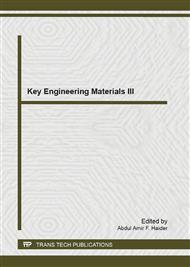[1]
Brinson, L. C., and R. Lammering. "Finite Element Analysis of the Behavior of Shape Memory Alloys and their Applications. "International Journal of Solids and Structures (1993): 3261-80. Print.
DOI: 10.1016/0020-7683(93)90113-l
Google Scholar
[2]
Auricchio, Ferdinando, Robert L. Taylor, and Jacob Lubliner. "Shape-Memory Alloys: Macromodelling and Numerical Simulations of the Superelastic Behavior." Computer Methods in Applied Mechanics and Engineering 146.3–4 (1995): 281-312. Print.
DOI: 10.1016/s0045-7825(96)01232-7
Google Scholar
[3]
Wilkes, Kenneth E., Peter K. Liaw, and Kenneth E. Wilkes. "The fatigue behavior of shape-memory alloys." JOM Journal of the Minerals, Metals and Materials Society 52.10 (2000): 45-51.
DOI: 10.1007/s11837-000-0083-3
Google Scholar
[4]
Nosonovsky, Michael, and Pradeep K. Rohatgi. "Thermodynamic Principles of Self-Healing Metallic Materials."Biomimetics in Materials Science (2012): 25-51.
DOI: 10.1007/978-1-4614-0926-7_2
Google Scholar
[5]
Burton, D. S., X. Gao, and L. C. Brinson. "Finite element simulation of a self-healing shape memory alloy composite." Mechanics of Materials 38.5 (2006): 525-537.
DOI: 10.1016/j.mechmat.2005.05.021
Google Scholar
[6]
Martinez-Lucci, J., et al. "Self-Healing in Metal Castings." American foundry society, (2011): 11-51.
Google Scholar
[7]
Mantovani, Diego. "Shape memory alloys: Properties and biomedical applications." JOM Journal of the Minerals, Metals and Materials Society 52.10 (2000): 36-44.
DOI: 10.1007/s11837-000-0082-4
Google Scholar
[8]
Tokuda, M., et al. "Thermo mechanical behavior of shape memory alloy under complex loading conditions." International journal of Plasticity 15.2 (1999): 223-239.
DOI: 10.1016/s0749-6419(98)00066-7
Google Scholar
[9]
Tarnita, D., et al. "Modular Orthopedic Devices Based on Shape Memory Alloys." SYROM 2009 (2009): 709-721.
DOI: 10.1007/978-90-481-3522-6_60
Google Scholar
[10]
Song, Chengli. "History and Current Situation of Shape Memory Alloys Devices for Minimally Invasive Surgery."Open Medical Devices Journal 2.1 (2010): 24-31.
DOI: 10.2174/1875181401002020024
Google Scholar
[11]
Descamps, Olivier. "The application of shape-memory alloys to sculpture." JOM Journal of the Minerals, Metals and Materials Society 43.3 (1991): 64-64.
DOI: 10.1007/bf03220168
Google Scholar
[12]
Adiguzel, O. "Smart materials and the influence of atom sizes on martensite microstructures in copper-based shape memory alloys." Journal of materials processing technology 185.1 (2007): 120-124.
DOI: 10.1016/j.jmatprotec.2006.03.111
Google Scholar
[13]
Ionaitis, R. R., V. V. Kotov, and I. M. Shchukin. "Application of shape-memory alloys in nuclear power." Atomic Energy 79.4 (1995): 712-714.
DOI: 10.1007/bf02415395
Google Scholar
[14]
Ortı́n, Jordi, and Lucas Delaey. "Hysteresis in shape-memory alloys." International Journal of Non-Linear Mechanics 37.8 (2002): 1275-1281.
DOI: 10.1016/s0020-7462(02)00027-6
Google Scholar
[15]
Han, L. H., and T. J. Lu. "3D finite element simulation for shape memory alloys."IUTAM Symposium on Mechanics and Reliability of Actuating Materials." Springer Netherlands, (2006): 227-236.
DOI: 10.1007/1-4020-4131-4_23
Google Scholar
[16]
Rahman, A. M. "Patents on superelastic shape memory alloy." Recent Patents on Mechanical Engineering 1 (2008): 65-67.
DOI: 10.2174/2212797610801010065
Google Scholar
[17]
Frotscher, Matthias, and G. Eggeler. "Recent Developments and Challenges in Shape Memory Technology." Nanotechnological Basis for Advanced Sensors, NATO Science for Peace and Security Series B: Physics and Biophysics, Volume. ISBN 978-94-007-0902-7. Springer Science+ Business Media BV, 2011, pp.531-1 (2011): 531.
DOI: 10.1007/978-94-007-0903-4_56
Google Scholar
[18]
Stirling, Leia, et al. "Applicability of shape memory alloy wire for an active, soft orthotic." Journal of materials engineering and performance 20.4 (2011): 658-662.
DOI: 10.1007/s11665-011-9858-7
Google Scholar
[19]
Liu, Hongjian, et al. "Biochemical evaluation of an artificial anal sphincter made from shape memory alloys." Journal of Artificial Organs 10.4 (2007): 223-227.
DOI: 10.1007/s10047-007-0395-y
Google Scholar
[20]
Uchil, Jayagopal. "Shape memory alloys—characterization techniques." Pramana 58.5 (2002): 1131-1139.
DOI: 10.1007/s12043-002-0229-7
Google Scholar
[21]
Al-Haidary, J. T., and Shadi Al-Khatiab. "Manufacturing and characterization of dental shape memory alloy." Materials Science and Engineering: A 419.1 (2006): 45-49.
DOI: 10.1016/j.msea.2005.11.061
Google Scholar
[22]
Sun, Q., and P. Feng. "Deformation Instability and Pattern Formation in Superelasti Shape Memory Alloy Microtubes."IUTAM Symposium on Mechanics and Reliability of Actuating Materials. Springer Netherlands, (2006): 207-217.
DOI: 10.1007/1-4020-4131-4_21
Google Scholar
[23]
Bellouard, Yves. "Shape memory alloys for microsystems: A review from a material research perspective." Materials Science and Engineering: A 481 (2008): 582-589.
DOI: 10.1016/j.msea.2007.02.166
Google Scholar
[24]
Pelton, A. R., D. Stöckel, and T. W. Duerig. "Medical uses of nitinol."Materials Science Forum.Vol. 327. (2000): 63-70.
DOI: 10.4028/www.scientific.net/msf.327-328.63
Google Scholar
[25]
Kim, Kyubum, and Samantha Daly. "Experimental Studies of Phase Transformation in Shape Memory Alloys." Mechanics of Time-Dependent Materials and Processes in Conventional and Multifunctional Materials, Volume 3 (2011): 81-87.
DOI: 10.1007/978-1-4614-0213-8_12
Google Scholar
[26]
Waitz, Thomas. "Bulk nanostructured shape memory alloys." Ciência & Tecnologia dos Materiais 20.1-2 (2008): 25-29.
Google Scholar
[27]
Brinson, L. C. "One-dimensional constitutive behavior of shape memory alloys: thermomechanical derivation with non-constant material functions and redefined martensite internal variable." Journal of intelligent material systems and structures 4.2 (1993): 229-242.
DOI: 10.1177/1045389x9300400213
Google Scholar


